SAGA Arthur Rises Again
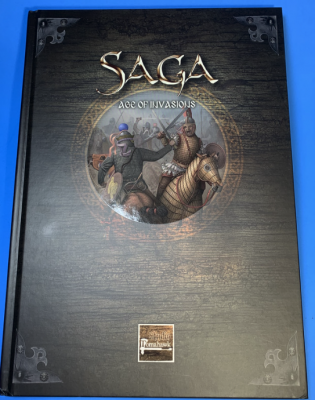 By Troy A. Hill
By Troy A. Hill
The wait is over. The designers at have released their latest revamp of a first edition book, rewritten and re-powered into second edition. The Saga Age of Invasions is upon us.
The podcasts and online forums are all buzzing as players discuss the new Battle Boards, strategies and what has changed. But, for a player new to Saga, like me, the new book and Battle Boards aren’t about what has changed.
Instead, it’s what are the flavors of the various factions. So, let’s take a dive into the book from a fresh noob’s point of view.
If you’re looking for a good breakdown on what is new compared to the old, I suggest Rodge and Monty over on Saga Thorsday Vlog. Their
Age of Invasions (AoI) covers the fifth century CE. The period, according to the historical text at the front of the book, covers the near-century of strife sparked in 406 CE when the Rhine froze and the Roman army was tied up fighting the Visigoths. This spurred the migrations of the “Barbarian” peoples into western Europe. This culminated in 476 when the last of the Western Roman Emperors, Romulus Augustulus, was dethroned.
Age of Invasions focuses on eight factions from this period, and brings in or tweaks a few new concepts for the warbands. The eight forces are: Romans, Huns, Goths, Britons, Saxons, Picts, Franks, and Sassanids. The usual Dogs of War (Mercenaries of the period), as well as Old Friends and New Enemies (Warbands using boards from other Age of… books). It also includes a section on Limes, a campaign system for Saga AoI that I’d love to get our local Saga group involved in.
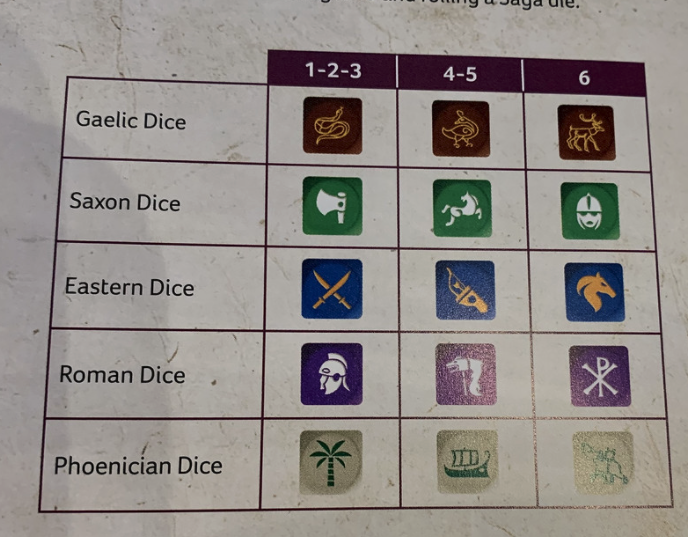 New Rules and Equipment
New Rules and Equipment
If you’re a fan of Age of Hannibal because – Elephants than you can name Stampy and Stompy, and let run amok through your opponent’s forces, you’re in luck. They return for AoI. The stats are the same as in Hannibal.
Another carryover from Hannibal is the War Chariot. However, instead of adding to your Hearthgard units, in AoI, only the band’s Warlord can be equipped with a War Chariot. It has bennies, increasing the range of their We Obey to L (12 inches) instead of S. However, the warlord’s aggression drops from 8 to 5. They do count as Mounted, however.
The Manuballista is sure to be added to many a Roman army in this age. This oversized crossbow counts as a unit of 6-levies for victory points, and as a unit of levies with missile weapons. However, it awards no saga dice to the pool. Instead, it has a special aggression rating. With a range of two times L (a total of 24 inches), the Aggression is half the number of figures in the targeted unit and it gets a +1 bonus to attack dice. This will easily challenge missile heavy levy units.
The piece of equipment that has most people gearing up for the new book is Cataphracts armor. Barding on your horses, as well as full body armor for the riders, give the units a penalty on their move distance, reducing it to M from L (Charge distance is still L). However, Cataphracts armored troops don’t suffer the usual penalty of -1 to their armor for being mounted.
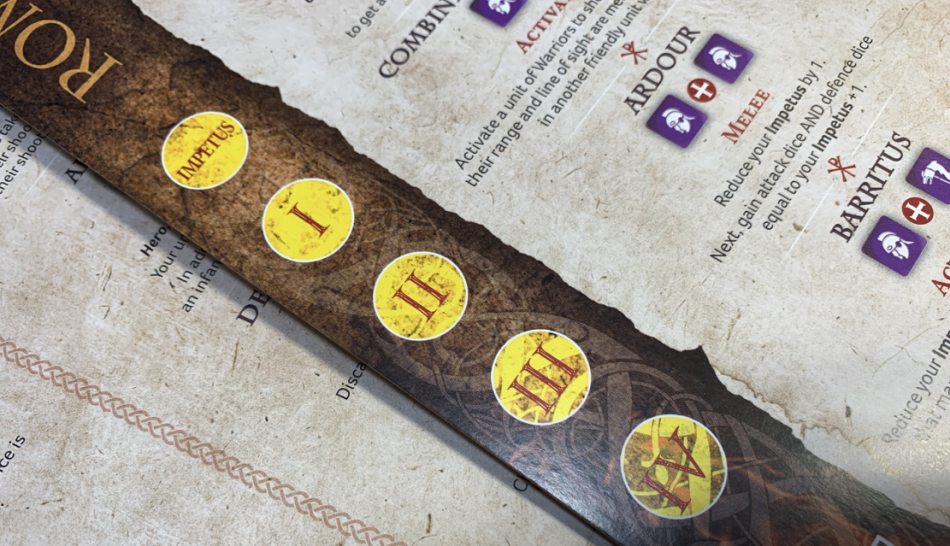 Romans
Romans
The first of the troop types in this era has to be the Romans in their final throws of a decaying empire. Their Battle Board include the Impetus special rule. The roman board has a space to the side for counting the impetus (elan or fighting spirit). The Roman Battle Board interacts with Impetus. Some board abilities whittle away at Impetus.
But fear not! Instead of the standard Activation Pool ability in the basic section of the Battle Board, Romans have Rallying Cry. This allows the player to increase their force’s impetus by one, or by two if a rare die is used. If your warband’s Impetus is 2 or less, it increased to 3.
No worries about losing out on the ability to roll extra Saga dice. The Adversity ability allows you to duplicate the reaction pool ability with a Rare (once per turn, since it’s an advanced ability).
Roman Warlords and Hearthgard can use Cataphracts armor, and the manuballista can be used in place of a levy unit.
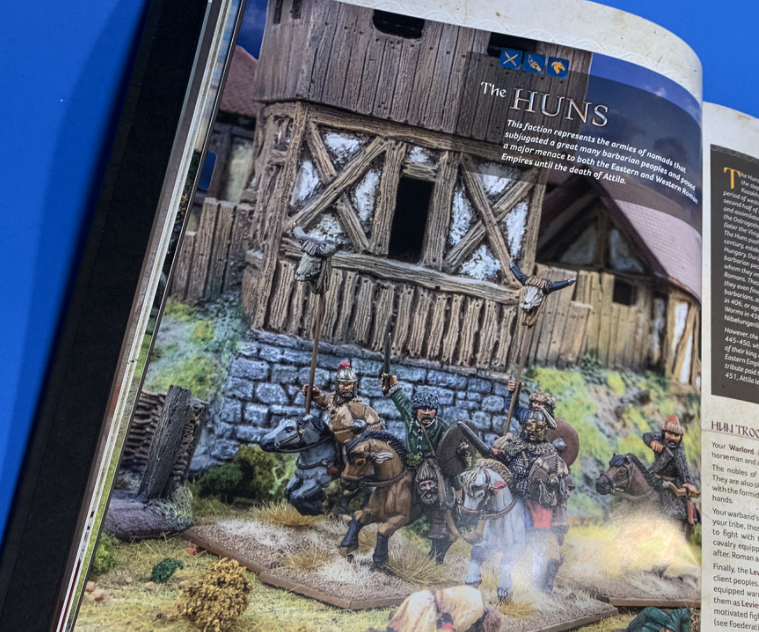 Huns
Huns
The entries for the Huns faction distinguishes that “Huns” count as your Warlord, Hearthguard, and Warriors from the faction. Levies and Mercenaries are not Huns, unless the mercenary unit has the Loyal special rule. Warlords, Hearthguard, and Warriors are all horse-mounted. Warriors have composite bows. Levies can be on foot and unarmed, or with bows. Or levies can be mounted on horses.
Although the basic abilities on the Battle Board are standard, the board is heavily fatigue related. Many abilities tweak your enemy’s fatigue, such as the Death from Above advanced ability. It gives the enemy unit targeted by a shooting attack a fatigue once the attack has been resolved.
Other advanced abilities either give bonuses to Hun units (not levies nor mercenaries without Loyalty). Some units combine both the Hun and the Fatique manipulation, such as the Encirclement ability. For an uncommon die, in the activation phase, All enemy units between two units of Huns (within L of each other) take a fatigue. Other advanced abilities grant bonus attack or defence die based on, or with extra bonuses based on enemy fatigue. This board combines Fatigue manipulation with combat bonuses in ways that may encourage aggressive play.
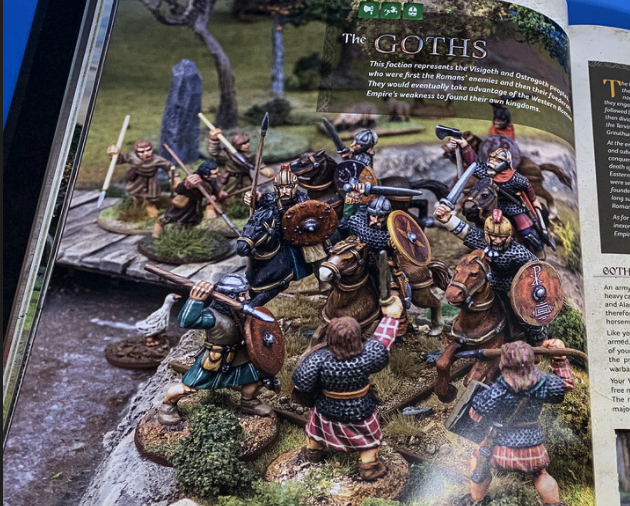 Goths
Goths
Although this is only one section, with one Battle Board, the Goths faction has slightly different equipment options for the Visigoths (Western) and Ostrogoths (Eastern) segments. The Visigoths have more limitations than their eastern brethren.
Both types of Warlords can be horse mounted, and can have cataphracts armor if mounted. However, Only the Ostrogoths can have mounted Hearthguard without the Warlord also being mounted. Both types can have Cataphracts armor if mounted.
Visigoth warriors have no equipment options, though the Ostrogoth Warriors can be mounted, with a requirement that mounted Warriors have to equal or exceed foot warriors in numbers. Levies are equipped with bows or slings in either sub-faction.

The Goths Battle Board has the standard basic abilities. The advance abilities, however, are again fatigue oriented. The Resolve ability requires an uncommon or rare Saga die, and allows the Goths player to activate a unit for a charge, but removes the ability of the opposing player to use the Goths unit’s fatigue.
The Weregild ability requires an Uncommon die, and in the Orders or Orders/Reaction phase, any time your opponent uses one of your fatigues, they place a fatigue on one of their units. The Sidonius Says section of the Goths’ entry in the book states this ability lasts until the end of the turn.
Arthur, King of the Britons
This faction is based on the last defenders of Roman Britain, and yes, it does have Arthur Pendragon as a legendary unit it can add. The Britons have fairly vanilla troop options. The warlord can be mounted, and the Hearthguard can only be mounted IF the Warlord is. Levies can have javelins, bows, or slings.
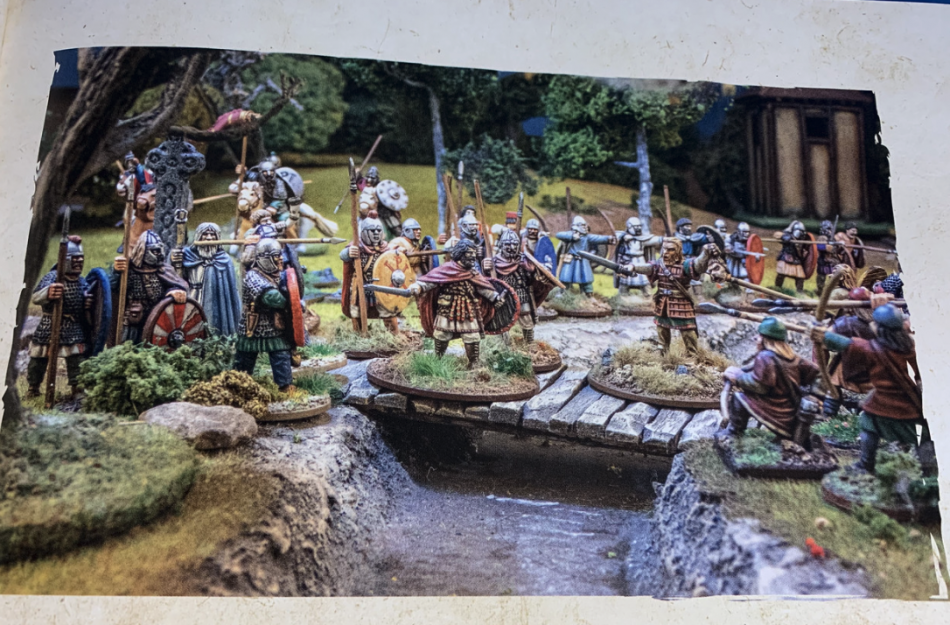
However, this faction uses the Galvanised special rule. Units with S of the Warlord from the Briton’s faction (not Mercenaries, Heroes, and, unfortunately, the warlord himself.) However, you can trade out two of your Hearthguard or four of your Warriors and give your Warlord some stalwart champions. This forms a heroic unit of the Warlord and two Companions at the beginning of the game. This unit counts as your Warlord plus two hearthguard and remains together for the game.
The Battle Board for the Britons is dominated by both Galvanisation and by the Warlord. In additions there are both offensive, and good defensive advanced abilities.
Tenacious (uncommon Saga die) gives a unit in melee two extra defence die. However, if the unit is galvanised, it may also cancel one casualty suffered in that melee. Pendragon (uncommon or rare dice) allows a Warlord or Heroic Unit in Melee to re-roll any attack dice that score 1s or 2s. A rare also allows you to remove a fatigue from that unit.
The Picts
From north of the Antonine wall come the Picts, precursors to the Scots. They are one of the bands which may use a war chariot for their Warlord. Mounted Hearthguard, like the Warlord in his chariot, are armed with javelins. Both may also be mounted on foot with no options.
This is one of the few factions where the levies may have crossbows.
Their Battle Board has some solid defense and attack advanced abilities. Many have bonuses around terrain of various types. The Ambush ability (common die) gives a unit in melee two additional attack dice. That increases by two dice IF the unit is within M of uneven or dangerous terrain.
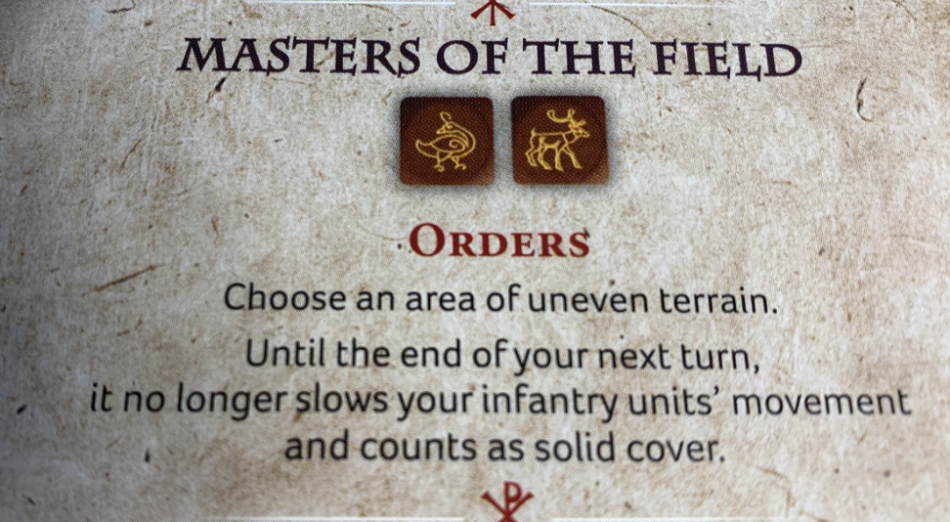
Although this board lacks the Chicken and Snake combo (Reach) of the Scottish board from Age of Vikings, Masters of the Field allows you to use either the chicken or the stag for a worthwhile ability. True, using a rare or an uncommon Saga dice is pricey. But, this ability allows you to choose a piece of uneven terrain. Until the end of your next turn that terrain counts as solid cover, and does not slow your infantry units’ movement.
The Franks
These sons of Francion (son of Priam from the Trojan War) charge onto the table with fairly generic options. All but the levies are on foot with no options. Levies get a choice of bows or slings. However, the Franks have the use of the Franciscas. This weapon is given to all heroes, hearthguard, and units of warriors with at least six figures when the ability is triggered. Mercenaries do not qualify for Franciscas.
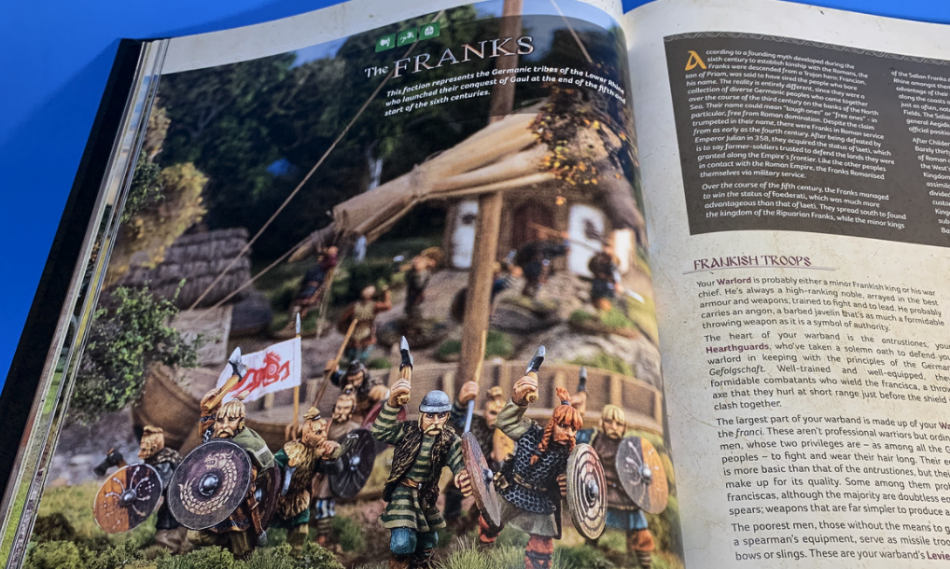
The Franciscas is tied into the advanced abilities of the Battle Board for this faction. The core of the advanced abilities on this board are Momentum and Show of Force. By activating Show of Force, you place three markers on this ability. For each melee you win, remove a marker. Once all three markers are removed, place them on Momentum. This is where things get interesting.
Momentum activates with a common die. You can remove any number of the momentum markers. Each marker entitles one of your units to gain Determination ad a +1 bonus to their attack die until the end of the turn. This is only activated during your orders phase however. Getting combats in early and winning them is a key to getting your Momentum stocked and ready to roll.
There are other abilities that apply only to units equipped with the franciscas, such as Impact. That ability (common and uncommon) allows your units equipped with franciscas to gain three bonus attack dice whenever they charge a unit of armor 4 or less. Playing this after Show of Force is one strategy to get your Momentum fully loaded with early attacks.
The Sassanids
Coming from the region we now know as Iran or Persia, the Sassanids are a mobile, shooty army, with options for Stampy and Stompy.
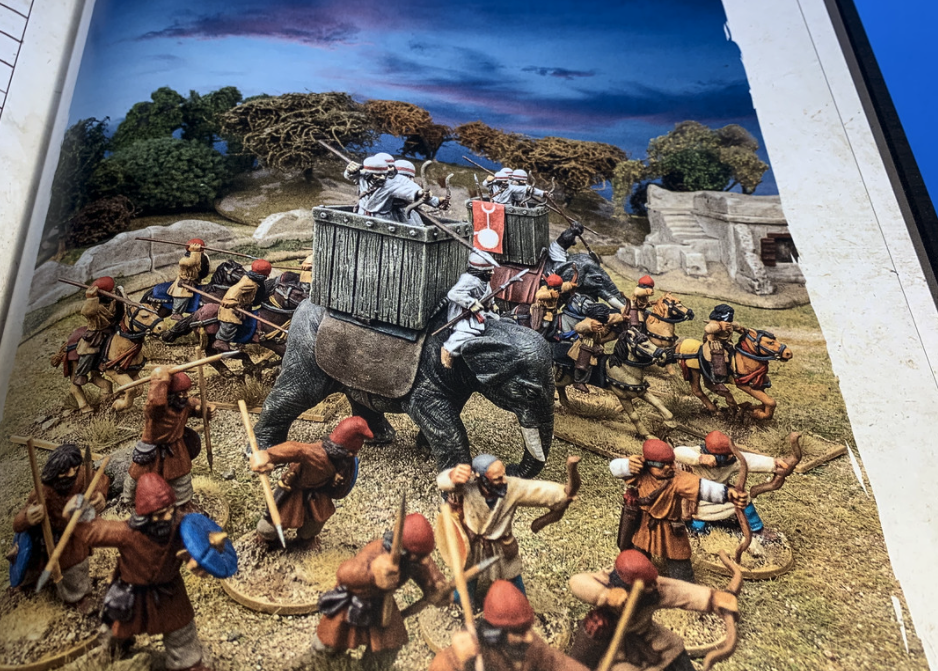
Your Sassanid warlord and hearthguard will be mounted with Cataphract armor. Warriors are also mounted, but with either normal weapons or with bows. Levies can also be equipped with bow. And, of course, you can add elephants.
The Sassanid Battle Board is a solid board with both defensive and offensive advanced abilities. Second Wind (common or uncommon) allow you to remove a fatigue from a friendly Elephant (your enemies elephants, if any, are definitely not friendly), or from any unit without ranged weapons. Defensive Posture (common) lets you dump two attack dice to get four defence dice.
But the most annoying to your enemies will be the Inexorable Advance ability. Any Saga die can activate this ability in Activation. Choose a hearthguard or elephant unit of yours. Every non-hero enemy unit within S of that unit is subject to this effect. Roll a die for each unit. If the roll is higher than the target’s shooting armor (or equal or greater than with a Rare Saga die), that unit takes a casualty. Your enemy will soon learn to avoid Stampy and your hearthguard lest they suffer the Inexorable Advance.
The Saxons
Another vanilla warband. Everyone on foot. Only the levies get the choice of weapons, with bows or slings. Their strength, however, lies in their Battle Board. It is attack and fatigue oriented.
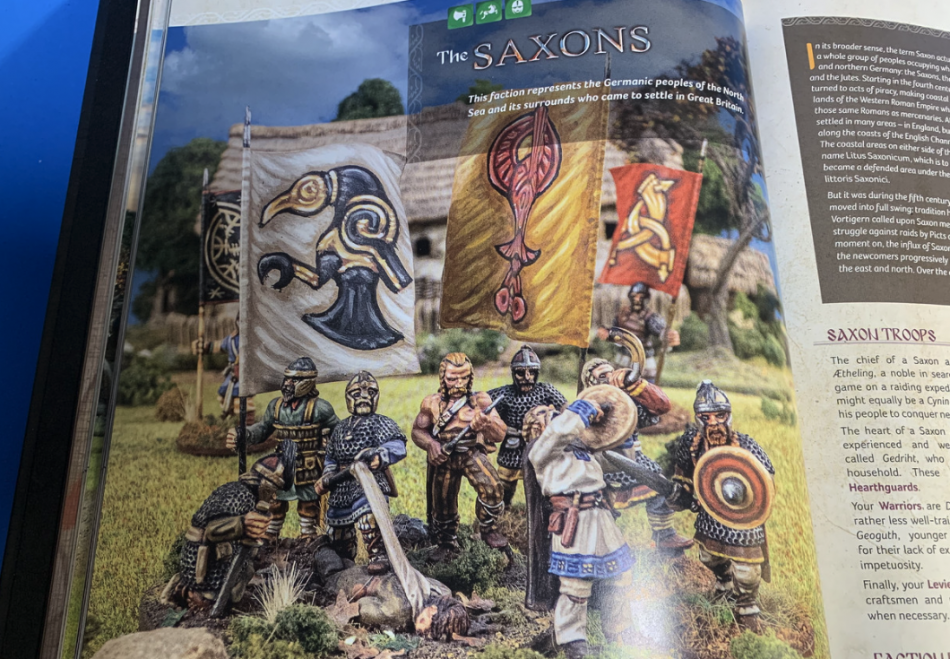
Offensive abilities include Implacable. For two common saga dice, a unit in melee gains two attack dies and half as many extra attack dice as their figures in the enemy unit.
Fatigue influencing include abilities like Jeers (an uncommon die). After a shooting attack, inflict on your enemy fatigues equal to half the casualties suffered by your unit. If your levies are going to be targets, the enemy might as well work hard for those kills.
Auto-hits are possible with the Death is Nothing ability. This requires a rare Saga die. During melee, one of your non-levy units can inflict (after attack dice are rolled) automatic hits equal to one-third of the hits taken by your troops. Your troops are sure to take an enemy out with them as they die on the field of honor.
Impressions and review
Since I’m still new to Saga, with only about a dozen games under my sword-belt, and all of them using troops from the Age of Vikings, my appraisal is shaded by my lack of experience.
However, I’m impressed with this book. Each of the Battle Boards only has ten advanced abilities. There are wide array of different play styles possible. From the defense minded Picts or Britons, who can also pack a wallop, to the aggressive Huns and Sassanids, or the tricksy Romans or Franks with the impetus and momentum, there is a plethora of potential, no matter your play style.
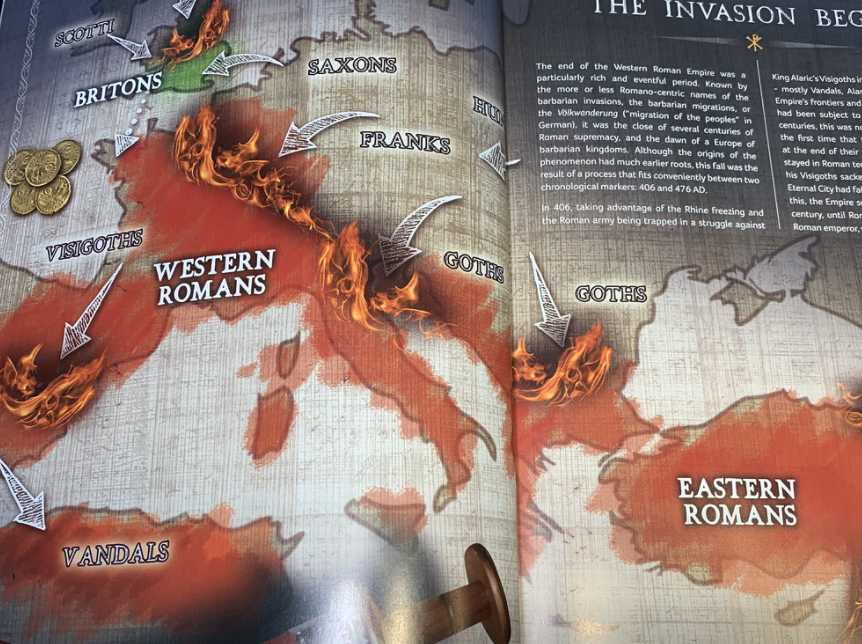 Troy is the editor of NoDiceNoGlory.com. When he’s not attempting to wrangle comma-splices and run-ons from our authors, he plays most things from Warlord Games, Saga, and writes novels. In the near future he hopes to sleep for an hour or two. Until then, his coffee IV and a bucket of cookies will keep him awake enough to get a game in soon.
Troy is the editor of NoDiceNoGlory.com. When he’s not attempting to wrangle comma-splices and run-ons from our authors, he plays most things from Warlord Games, Saga, and writes novels. In the near future he hopes to sleep for an hour or two. Until then, his coffee IV and a bucket of cookies will keep him awake enough to get a game in soon.
